The 27-inch Apple iMac Review (2011)
by Anand Lal Shimpi on May 27, 2011 2:30 AM ESTPower, Thermals and Noise
I started this review complaining about how loud the 15-inch MacBook Pro gets, but with 32x the physical volume the 27-inch iMac is near silent. Even under load the system is very quiet, almost too quiet. Apple chose a very lax fan profile which results in some very high external temperatures. The iMac takes in cool air from the bottom of the display and exhausts it up top behind the display. Playing Half Life 2 Episode Two I measured a maximum surface temperature of 125F at the exhaust vent. Again, unless you're doing something weird with the iMac on your lap this isn't an issue. Keep in mind that the Sandy Bridge CPU in the 15-inch MacBook Pro carries a 45W TDP and what's in the iMac is either 65W or 95W. Add in a larger, hotter hard drive and potentially a beefier GPU and you have a recipe for a pretty warm machine.
| 2011 iMac Power Usage | ||||||
| 27-inch iMac (Mid 2011) | Idle | Cinebench R11.5 | Half Life 2 Episode Two | |||
| Minimum Brightness | 54.1W | 108.3W | 149.0W | |||
| 50% Brightness | 86.6W | 141.6W | 180.0W | |||
| 100% Brightness | 144.5W | 198.3W | 240.0W | |||
With a large integrated display power consumption obviously varies depending on brightness. At idle, power consumption ranges from 54W to 144W. Under load the range quickly gets ever higher. I measured max system power consumption at 240W running Half Life 2 Episode Two.
Power consumption isn't out of control but you've got a billion transistor CPU, a 1.7B transistor GPU and a high resolution 27-inch display + backlight - it's going to draw some power.
Performance
Having never previously been a fan of the iMac, I don't actually have any historical performance data to compare to. What I do have however are scores from Mac Pros and of course the MacBook/MacBook Pro lines from the past couple of years.
Adobe Photoshop CS4 Performance
The Retouch Artists Speed Test we use for our CPU testing under Windows also works under OS X. We're running the exact same benchmark here, basically performing a bunch of image manipulations and filters and timing the entire process.
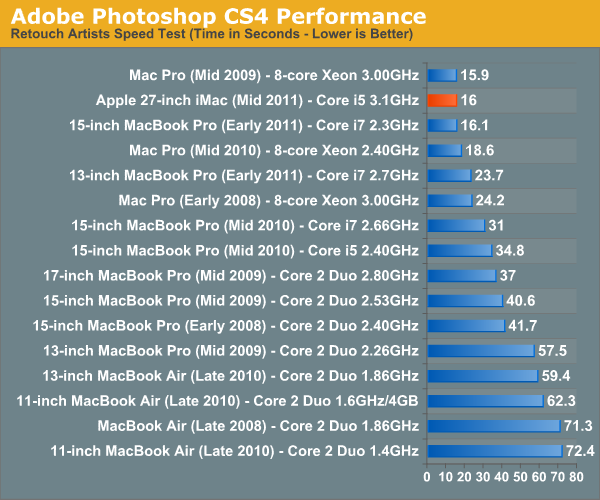
The high-end 27-inch iMac is a very capable Photoshop machine. A hair faster than the new MacBook Pro, the iMac delivers the same performance as an 8-core Mac Pro from 2009 or 2010.
Aperture 2 RAW Import
For my Aperture test I simply timed how long it took to import 203 12MP RAW images into the library.
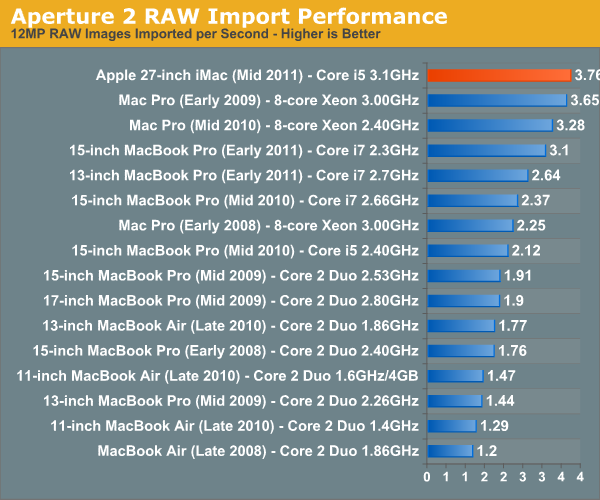
We have a new winner here! The MacBook Pros were always limited by their slower 2.5" hard drive, but the iMac with Sandy Bridge in additional to a speedier disk give us better image import performance than the '09 and '10 Mac Pros. I told you this thing was fast.
Cinebench R10 & 11.5
I’m a fan of the Cinebench tests because they lets me show off both single and multithreaded performance in the same workload. First, the single threaded performance:
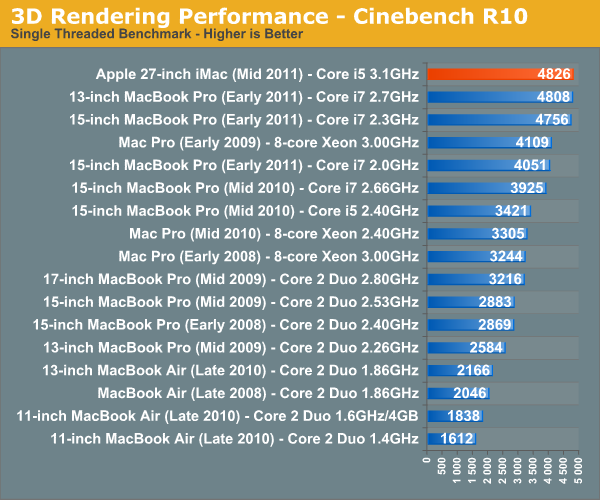
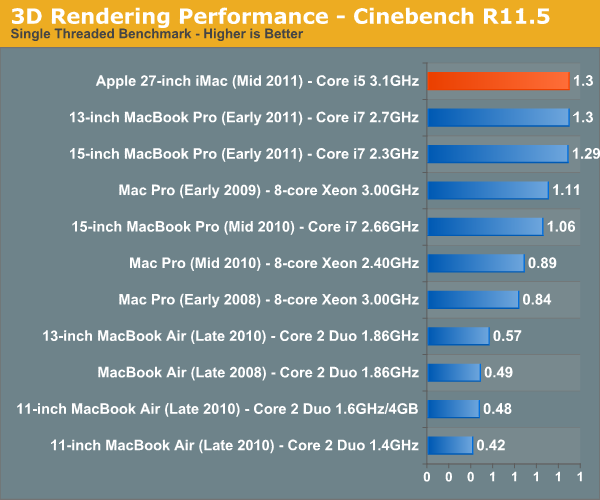
Sandy Bridge quad-core CPUs make no sacrifices. You get excellent single threaded performance which means general OS usage, launching applications and even rendering most web pages happens as fast as physically possible as the other cores are power gated and asleep. Start multitasking however and you'll see the Core i5 in this machine is no slouch:
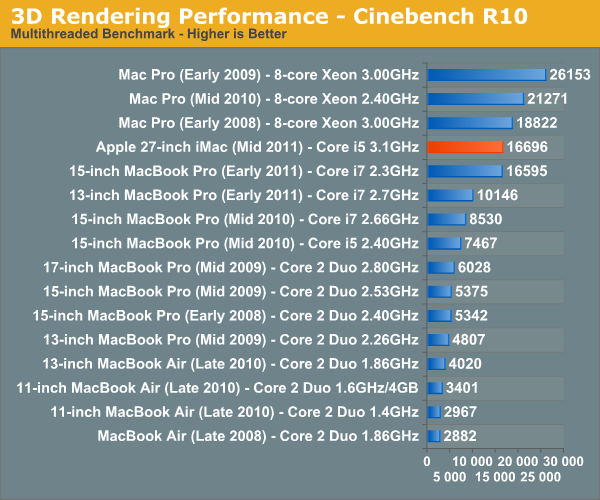
There's still no replacement for more cores when it comes to heavily threaded applications, the past three years of 8-core Mac Pros are still faster than the new 27-inch iMac here. I suspect the upgraded Core i7 would at least let the iMac beat the 2008 Mac Pro thanks to Hyper Threading, but the other two systems are simply out of reach. For those users, you're better off waiting for the Sandy Bridge-E Mac Pro update expected sometime in Q4.
You'll notice in Cinebench R10 the 15-inch MacBook Pro is nipping at the heels of the new iMac. Chalk that up to the larger L3 cache and Hyper Threading, both advantages enjoyed by the MacBook Pro. Look at what those advantages do in Cinebench R11.5's multithreaded test:
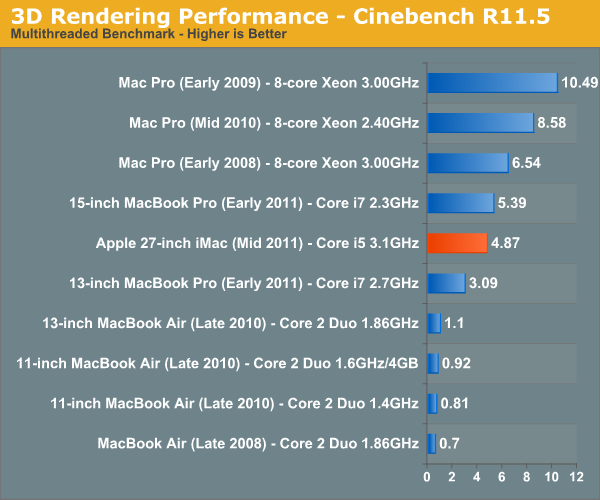
Here the MacBook Pro actually gains on the iMac. More threads and more cache are better suited for the Cinebench workload. If you do a lot of offline 3D rendering and you want the iMac, I'd suggest upgrading to the Core i7-2600 that Apple offers. You get a not insignificant boost in clock speed but more importantly, Intel switches on Hyper Threading which gives you twice as many threads.
Quicktime H.264 Video Encoding
Our final benchmark is more consumer focused. Here I'm taking an XviD and converting it to an iPhone-supported H.264 format.

QuickTime doesn't make tremendous use of all cores all of the time, and thus the MacBook Pro loses its threading advantage. The iMac is our new champion of this test.










139 Comments
View All Comments
iwod - Friday, May 27, 2011 - link
My problem is with Apple's Memory upgrade. They have 2x 2GB fitted which means if you want 8GB you either have to pay sily amount to apple, or buy 4GB x2 yourself and sell your original to someone else.As soon as the hardware encoder inside Intel can be accessed through Mac OSX, i believe 4 Core 8 thread will be enough for 99.9% of my task. Next year iMac GPU upgrade should be much more important then CPU IvyBridge.
And only if Apple actually make Z68 Intel SRT to work. We need SSD, in cache or main drive.
setzer - Friday, May 27, 2011 - link
Actually these iMacs have 4 so-dimm slots, so you should be able to get 8gb's fairly easily and cheap, though if I was changing the memory I would also change the hdd in one go, opening that can is hard work..FATCamaro - Friday, May 27, 2011 - link
Yeah I bought the 27" with the SSD upgrade and bought memory separately. SSD isn't that much more than retail and the imac is a pain to open. The memory is a bit of a ripoff though.Zandros - Friday, May 27, 2011 - link
Isn't the memory accessible through removing a single screw at the bottom of the iMac, though? No need to go in through the display just for that.archer75 - Friday, May 27, 2011 - link
Actually it's 3 screws ;)But there are 4 ram slots. I just bought 16gb from newegg and plugged it in. Cost less than what apple would charge for 8gb.
KoolAidMan1 - Friday, May 27, 2011 - link
Anand - First off, great review as always.The conclusions you reached regarding the iMac's performance "finally" getting to an acceptable point is something that I came to with the release of the mid-2007 24" iMacs. Prior to that I had a PowerMac workstation for Final Cut Studio. The Core 2 Duo used in the 2007 iMac convinced me that an all-in-one would finally be a suitable replacement instead of a Mac Pro, and it was. It cost me much less than a Mac Pro while still giving me good performance and it had a 24" IPS display built in, which at the time ran $1000 by itself from NEC or Apple.
The 27" iMac released in late 2009 was a similar deal: a powerful i7-860 machine combined with a $1000 27" IPS display. iMacs make upgrading simple too, you just pack the whole thing in the original box and ship it off. The only thing you have to mental your way past is letting go of the display, and that isn't hard for me based on the fact that the 27" display in the current iMac is spectacular. It was a more than worthwhile upgrade from my prior 24" iMac, and it didn't cost me too much given that I sold the old one for about 60% of what I paid.
The 27" iMac display also functions as the primary display for my gaming PC. Unlike the iMac, my PC has SLI video cards so it can tear through that 2560x1440 res with no problem. Unlike the iMac, my PC isn't for work, it is for play. :)
This brings about my main issue with the 2011 iMacs, and it isn't something that was addressed in this review. I'm talking about the new requirements for Target Display Mode (using the iMac as a monitor for an external source) now that the mini-DP port was replaced with a Thunderbolt port. The only sources that you can use on the new iMacs are those equipped with Thunderbolt ports. For the time being this limits you to 2011 Macs, that's it. No old Macs, and no PCs until next year at the soonest.
Coming from someone that uses an iMac as an external display every day, that is pretty disappointing. Perhaps an active adapter or something will come out, but for the time being it really limits that aspect of the new iMacs.
Thanks again!
KoolAidMan1 - Friday, May 27, 2011 - link
Sidetrack - I suggest testing Starcraft 2 with ultra textures and medium settings. My PC has plenty of juice to run with everything cranked, but unless you take a still frame and examine it, the difference in visual quality between medium and ultra settings is not noticeable. The difference in framerate is VERY noticeable though, which is why I run at medium settings with ultra textures. Nice and fast while still looking pretty.I'm very curious to see how the new iMacs would run with those settings. In my own experience you're looking at nearly a doubling in framerate, but that is also with an SLI setup that may not have the same performance delta as the single GPU in the iMac. I also saw a huge difference with my laptop, but I didn't examine the framerate as closely with it so I can't say for sure if it is "nearly double" in that case.
jonwd7 - Friday, May 27, 2011 - link
The price comparison chart on the first page is wrong. I haven't made it through your review far enough to tell, but either you did not receive the high-end iMac, and you're quoting the wrong price ($1999) for the stats you've listed, or you did receive the high-end iMac, the price is right, but the stats are wrong.The stats you have listed are for the $1699 model.
krazyderek - Friday, May 27, 2011 - link
i noticed this as well, specifically this means,the $1999 model currently features the 6970 1gb, and 3.1ghz quad core i5
the $1699 model currently features the 6770 512mb not the 5xxx
in fairness the $1499 model should really be used along with the $1199 to compare to those other price points.
The $1999 model is in a completely different class and should be compared to it's appropriate competitors
psonice - Friday, May 27, 2011 - link
I'd say this isn't really much of an issue. When most people upgrade, they sell their old box - and the mac holds its value incredibly well. So what actually happens is in a couple of years you sell the old box for a large chunk of cash, and spend a smaller-than-expected sum on the new one.Basically, macs are surprisingly cheap when you factor in the resale value. You either keep them long term (and they pay for themselves then anyway), or you sell after a few years and get half your money back. This is assuming it doesn't break down - if that happens, they're very expensive ;)
Example: My 2007 24" imac was ~£1200. Resale value for similar spec on ebay today: ~£650-700. That means it's cost me around £500-£550 over 4 years, roughly the cost of a low-end desktop with an OK screen.
Oh, and I did upgrade mine to SSD (I've ignored that when looking at the prices). Yeah, it's a "fun" upgrade, and I ditched the HDD completely so I missed out on the 'removing the motherboard' stuff. Suction cups aren't actually required - you can get by with a pair of car windscreen mounts for GPS.
An easier way to access the HDD would be very welcome - especially as the new ones come with a special SATA connector so you'd need to buy an apple-specific drive too! (Not sure if this was covered in the article, I skipped a lot of it, but it's a pretty major downside for us technical types - the average punter probably wouldn't care less).